



This year the Linares 2009 tournament is being staged only in Spain – in the previous three years the first half was in Morelia, Mexico, and next year the first half will probably be in the Arab Emirates. The 2009 event goes from February 1th to March 7th, with three rest days. The prize fund is 314,000 Euros, with the winner getting 100,000 Euros, followed by 75,000 and 50,000 Euros for second and third place. There are no appearance fees for the players, so the motivation to fight for points may be unusually high. The venue is el Teatro Cervantes de Linares, the starting time of the games is 16:00h (4 p.m.) Spanish/European time.
Round 2: Friday, 20 February 2009 |
|||
Teimour Radjavov |
½.½ |
Vassily Ivanchuk | |
Alexander Grischuk |
1-0 |
Wang Yue | |
Magnus Carlsen |
½.½ |
Lenier Domínguez | |
Vishy Anand |
0-1 |
Levon Aronian | |
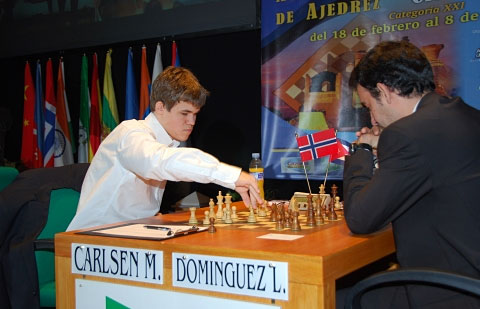
In Carlsen-Dominguez the Cuban Grandmaster demonstrated a great preparation, introducing a novelty in a very sharp and relatively new theoretical variation. After some thought the Norwegian took a healthy practical decision to play safely and repeat the position instead of playing wild complications analyzed by his opponent at home.

A cool character: Leinier Dominguez from Cuba
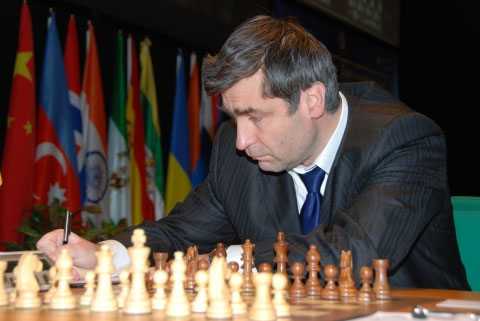
Vassily Ivanchuk, top Ukrainian GM
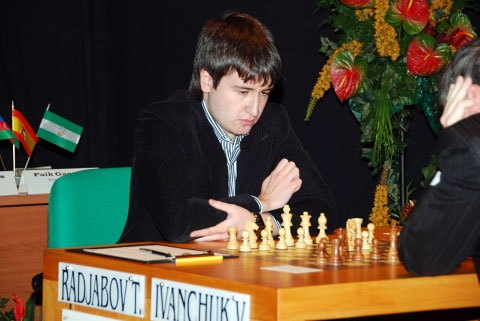
Teimour Radjabov from Azerbaijan
Radjabov-Ivanchuk: Ivanchuk “dared” to play King’s Indian with black against Radjabov, who is known to be a virtuoso of this opening himself with the black pieces. The Azerbaijani tried a novelty, but Ivanchuk reacted strongly and soon Black achieved a comfortable equality. A draw was predictable long before it was agreed.
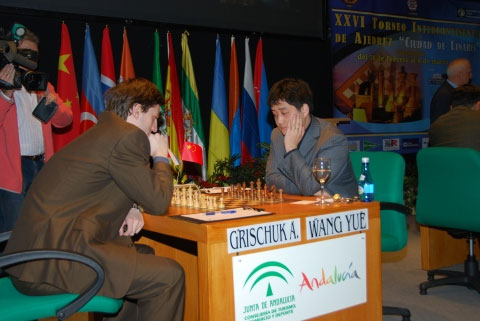
Grischuk and Wang Yue repeated the opening they played in December 2008 in the Grand Prix tournament in Russia. In spite of the fact that Grischuk won that game as well, today in Linares he implemented a different plan and also achieved an advantage. The Russian Grandmaster played a good positional game, slowly but firmly increasing the advantage and finally converting it into a full point in the different-coloured bishops endgame. The Chinese failed to put up his usual tenacious resistance.

Moscow GM Alexander Grischuk now in the lead with Aronian
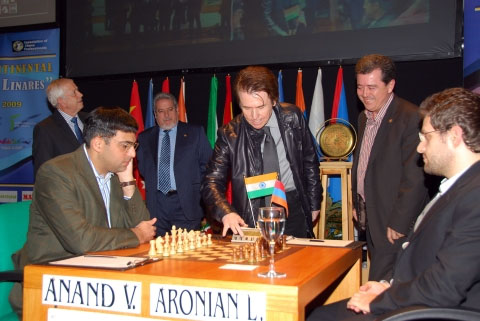
"Rafael" (Don
Rafael Martos Sánchez), a well-known Spanish singer, starts the clock
Anand-Aronian: the sensation of the round was Anand’s loss with the white pieces against Aronian. This game showed that even in a position with advantage it is far from easy to handle things when the opponent is always creating some problems. Anand played brilliantly until move 33, just like yesterday, showing a perfect precision. However, in contrast to his game versus Radjabov yesterday, today the position was very sharp and Black always kept counterchances. On move 33 Anand collapsed under the pressure and in his desire to exchange queens missed a simple tactical trick by Aronian, after which the evaluation changed dramatically. A sad result for Anand, but Aronian must be praised for his courageous play.
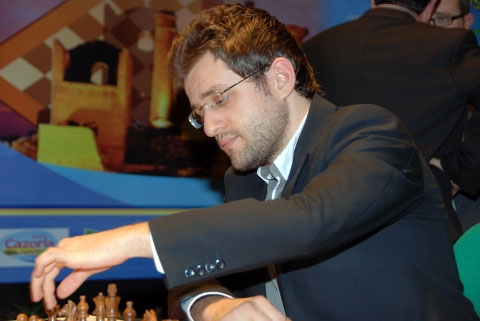
Tricked the World Champion and scored a valuable point: Levon Aronian
Carlsen,M (2776) - Dominguez Perez,L (2717) [A33]
XXVI SuperGM Linares ESP (2), 20.02.2009
1.c4 c5 2.Nf3 Nc6 3.d4 cxd4 4.Nxd4 Nf6 5.Nc3 e6 6.g3 Qb6 7.Ndb5 Ne5 8.Bf4
Nfg4
|
9.Qa4. This astonishing move was introduced into practice last year by Aronian, who surprised Leko in Morelia 2008. 9...g5. Faced with a new situation in the above-mentioned game this advance took Leko 80 minutes of thought. Dominguez spent less than a minute for it. His next moves were played a tempo as well – a clear sign of good home preparation. 10.Bxe5 Qxf2+. An important novelty! In the game Aronian-Leko, Morelia 2008 Black continued 10...Nxe5. 11.Kd1 Nxe5 12.Nc7+ Kd8 13.Nxa8 Qd4+ 14.Kc2 Nxc4 15.Kb3. Without preparation Carlsen wasn't ready to test the most principled continuation 15.e4 Qd2+ 16.Kb3 Qxb2+ (16...Ne3 loses: 17.a3 Qc2+ 18.Ka2) 17.Kxc4 d5+ (Not 17...Qxa1 18.Qa5+ b6 19.Qxg5+ Be7 20.Qe5 winning) and here White must find 18.Kd3! (18.exd5 Bg7 favours Black) 18...Bg7 19.Ne2
|
Anand,V (2791) - Aronian,L (2750) [D47]
XXVI SuperGM Linares ESP (2), 20.02.2009
1.d4 d5 2.c4 c6 3.Nf3 Nf6 4.Nc3 e6 5.e3 Nbd7 6.Bd3 dxc4 7.Bxc4 b5 8.Bd3 Bd6 9.0-0 0-0 10.Qc2 Bb7 11.a3 [11.Ng5] 11...a6 12.Ng5. A positional pawn sacrifice, which has been played before with the pawns on a2/a7 (without the inclusion of moves 11.a3 a6). 12...Bxh2+. The merit of inclusion a3/a6 can be seen in the following variation. In case of 12...h6 13.Nge4 Nxe4 14.Nxe4 Be7 White can use the pawn on a3 by continuing 15.b4 with an edge. 13.Kxh2 Ng4+ 14.Kg1 Qxg5 15.f3 Ngf6 16.e4 Qh4 17.Be3
|
For the sacrificed pawn White has a strong pawn center and the bishop pair. Besides, Black has problems with the coordination of his pieces. 17...e5 18.Ne2 Nh5 19.Qd2. Threatening to catch the black queen with 20.Bg5. 19...h6 20.Rfd1 Rae8 21.Bc2 Re6!? Very brave play from Aronian, who is not willing to defend a passive position and instead wants to create an attack on the kingside. Perhaps already here the Armenian foresaw the following piece sacrifice. 22.Bf2 Qe7 23.g4! The World Champion shouldn't be asked twice. Anand simply follows the strongest plan for White: g4 followed by Ng3-f5, increasing the space advantage on the kingside without being afraid of possible weaknesses, since Black's attacking potential is insufficient. 23...Rg6 24.Kf1 Nhf6 25.Ng3
|
25...Nxg4. A wise practical decision from Aronian. Objectively it doesn't change the evaluation: White will have a clear advantage after it, but suddenly Anand will have to solve defensive problems as well. [25...Qe6 26.Nf5 White gets what he wants: an easy play with great compensation for the pawn. 26.fxg4 Qh4. Weaker is 26...Rxg4 27.Nf5 Qf6 28.Qc3 Re8 29.Qf3 Rf4 30.Qg3 with large advantage for White. 27.Nf5 Qxg4 28.Qc3. In spite of the fact that after 28.Ne7+ Kh7 29.Nxg6 fxg6 White remains with a rook up, the remaining black rook comfortably enters the game without having to make any moves. 28...Re8 29.Qg3. Anand would be happy to exchange queens and thus completely neutralize opponent's threats against white king. Aronian obviously tries to avoid it. 29...Qh5 30.Qh4 Qf3 31.Rd3 Qg2+ 32.Ke2 exd4
|
33.Rg3?? The desire to exchange queens as quick as possible backfires. White has sufficient defensive resources and shouldn't have worried so much about his king on e2. After 33.Rxd4 Anand would have kept a large advantage, since White will start soon to create his own threats against black king. Besides, the queen on g2 is exposed and Black will have to exchange queens himself, which would lead to a very difficult endgame for him. In case of 33...Ne5 34.Rd8 Qf3+ 35.Ke1 Rxd8 (or 35...Rge6 36.Nd4) 36.Qxd8+ Kh7 37.Ne7 Qh1+ 38.Kd2 Nc4+ 39.Kc3 Qh3+ 40.Bd3 it is Black who gets mated. 33...Rxg3 34.Qxg3? 34.Nxg3 was called for, but Anand misses Black's answer. 34...Rxe4+!
|
It turns out that the rook cannot be taken due to the loss of knight f5. Thus with the last two moves White only lost his two central pawns. This is enough for Black to have a winning position now. 35.Kd2 Rg4! 36.Qxg2 Rxg2 37.Ke2 c5. Five pawns are just too much for the bishop. Black is completely winning. 38.Rg1 Ne5 39.Rxg2 Bxg2 40.Kd2 h5 41.b4 Nc4+ 42.Kc1 Nxa3 43.Bd1 cxb4 44.Bxh5 g6 45.Ne7+ Kf8 46.Nxg6+ fxg6 47.Bxg6 Ke7 48.Bxd4 Kd6 49.Bd3 Nc4 50.Bg7 a5 51.Be2 Be4 52.Bf6 a4 53.Bg7 Kd5 0-1. [Click to replay]
Grischuk,A (2733) - Wang Yue (2739) [D17]
XXVI SuperGM Linares ESP (2), 20.02.2009
1.d4 d5 2.c4 c6 3.Nf3 Nf6 4.Nc3 dxc4 5.a4 Bf5 6.Ne5 Nbd7 7.Nxc4 Nb6 8.Ne5 a5. A pet line of several Chinese Grandmasters, who show a stable belief in their beloved opening variations by using them again and again. This approach has advantages and drawbacks. One gets to know one's own variation in deepest details, but on the other hand one should always be ready to face very well prepared opponents. 9.e3 g6 10.Bd3 Be6. More natural looks the move preferred by another Chinese GM - Bu Xiangzhi 10...Bxd3 Black achieves a solid position after it: 11.Nxd3 Bg7 12.0-0 0-0 13.Qe2 Nfd5 14.Rd1 Nb4 15.b3 N6d5 with equality, Adianto,U (2589)-Bu Xiangzhi (2671)/Doha 2006. 11.0-0. Two month ago Grischuk prepared the advance of the e-pawn and won as well: 11.Be2 White needs this move in order to protect pawn d4. 11...Bg7 12.e4 Nfd7 13.Nf3 Bg4 14.0-0 0-0 15.h3 Bxf3 16.Bxf3 e5 17.d5 Re8 18.g3 Qe7 19.b3 Rad8 20.Be3 cxd5 21.Nxd5 Nxd5 22.Qxd5 b6 23.Qb5 Bf8 24.Rad1 Qb4 25.Be2 Nc5 26.Qxb4 axb4 27.Bc4 Kg7 28.Kg2 f6 29.Bd5 Rb8 30.Rc1 Na6 31.Rc6 Bc5 32.a5 Bxe3 33.fxe3 Nc5 34.axb6 Nd7 35.Rc7 Re7 36.Bc6 Rxb6 37.Rxd7 1-0 Grischuk,A (2719)-Wang Yue (2736)/Elista 2008. 11...Bg7 12.f4 Nfd7. This and the next move produce a strange impression – Black will remain with a broken pawn structure after it. 13.Nf3 c5. 13...h6 14.e4 is also hardly a solution for Black. The best is 13...Bc4 but then the question is why hasn't Black exchange these bishops on move 10? 14.Ng5! cxd4 15.Nxe6 fxe6 16.Ne4
|
White has a nice compensation for the pawn: the better pawn formation and the bishop pair. 16...0-0 17.Qg4 Rf5 18.Qh3 Nc5 19.Nxc5 Rxc5 20.Qxe6+ Kh8 21.e4 Rac8 22.e5 R8c6 23.Qf7 Nd5 24.Bd2 Qf8 25.Qxf8+ Bxf8 26.Rac1 e6 27.Kf2 b6 28.Kf3 Kg7 29.g3 Rxc1 30.Rxc1 Rxc1 31.Bxc1 Kf7 32.Bc4 Ne3 33.b3 Bc5 34.Ke2 h5 35.Bb2 g5. A waiting strategy doesn't help either. For instance: 35...Ke7 36.Bd3 Kf7 37.Be4 Kg7 38.h3 Kf7 39.Bf3 Ke7 40.Kd3 Nf5 41.g4 Nh4 42.Be4 and White wins the pawn d4. 36.fxg5 Ng4 37.Bd3 Nxe5 38.Be4 Ng4 39.h3 Ne3 40.Bc1 e5
|
41.Bxe3! dxe3 42.h4 Kg7 43.Kf3 Kf7 44.Bd3 Bd4 45.Be2 Kg7 46.Ke4 Kg6 47.Bd1 Bc3 48.Kxe3 Kf5 49.Bxh5 Be1 50.Kf3 e4+ 51.Kg2 Bc3 52.Be2 Be1 53.Kh3 Bf2 54.Bb5 Be1 55.Bd7+ Ke5 56.Kg4 e3 57.Bb5 Kd5. White wins easily: 57...Kd5 58.h5 Ke6 59.h6 Kf7 (Or 59...Bc3 60.g6 Kf6 61.g7 Kf7 62.Bc4+) 60.Kf5 Bc3 61.g6+ Kg8 62.Bc4+ Kf8 63.g7+. 1-0. [Click to replay]
Radjabov,T (2761) - Ivanchuk,V (2779) [E94]
XXVI SuperGM Linares ESP (2), 20.02.2009
1.d4 Nf6 2.c4 g6 3.Nc3 Bg7 4.e4 0-0 5.Nf3 d6 6.Be2 e5 7.0-0 Na6 8.Re1 c6
9.Bf1 exd4 10.Nxd4 Qb6 11.h3 Ng4 12.hxg4 Qxd4 13.Qxd4 Bxd4
|
14.Rd1. A novelty, which failed to impress. [14.g5]. 14...Bxc3! 15.bxc3 Bxg4 16.f3 Be6 17.Bf4 Rfd8 18.Bxd6 b6 19.a4 Nc5 20.Bxc5. 20.a5 runs into 20...Nb3 and White must continue 21.axb6 Nxa1 22.b7 Rab8 23.Bxb8 Rxb8 24.Rxa1 Rxb7 where there is not even a shadow of advantage. 20...bxc5 21.Rxd8+ Rxd8 22.Rb1 Kg7 23.a5. [23.Rb7 Rd7=] 23...Rd2 24.Rb7 a6 25.Rb6 Ra2 26.Rxc6. 26.Rxa6?? Ra1 27.Kf2 Rxf1+ 28.Kxf1 Bxc4+ and Black wins. 26...Rxa5 27.f4 Kf8 28.Bd3 Ke7 29.f5 gxf5 30.exf5 Bd7 31.Rb6 f6 32.g4 h6 33.Be4 Ra4 34.Bd5 a5 35.Kf2 Ra3 36.Be6 Bxe6 37.Rxe6+ Kf7 38.Rc6 Rxc3 39.Rxc5 a4 40.Rc7+ Kg8 41.c5 a3 42.Ra7 h5 draw. [Click to replay]

|
|
||||||||||||||||||||||||||||||||||||||||
|
|
||||||||||||||||||||||||||||||||||||||||
|
|
||||||||||||||||||||||||||||||||||||||||
|
|
||||||||||||||||||||||||||||||||||||||||
|
|
||||||||||||||||||||||||||||||||||||||||
|
|
||||||||||||||||||||||||||||||||||||||||
|
|
||||||||||||||||||||||||||||||||||||||||
Links
The games are being broadcast live on the official web site as well as on the chess server Playchess.com. If you are not a member you can download the free PGN reader ChessBase Light, which gives you immediate access. You can also use the program to read, replay and analyse the PGN games. |
 |